ECE's Kitt Peterson Exposes Local Middle Schoolers to Rapid Prototyping
May 6, 2016
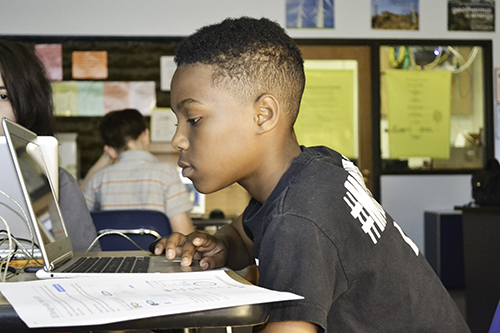
A Jefferson Middle School student uses TinkerCAD to create a 3D design for his keychain.
While it will be several years before Champaign-Urbana’s current crop of middle school students get the keys to their own car, at least a number of them now have a key chain to put them on. And it’s one that they designed themselves, thanks to ECE graduate student Kitt Peterson and MechSE’s Education Coordinator, Joe Muskin, who developed a curriculum that introduces rapid prototyping to sixth graders. So during the 2015–2016 school year, around 90 middle school students at Jefferson, Franklin, and Edison Middle Schools learned how to use TinkerCAD, a free, online software, then designed key chains, which were then 3D printed.
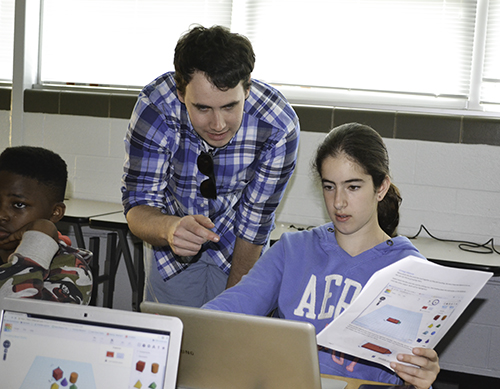
Kitt Peterson (center) helps a Jefferson Middle School student solve an issue she's having with TinkerCAD.
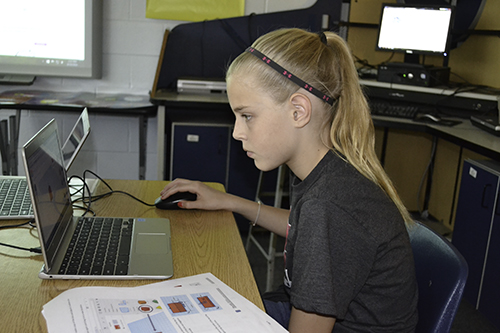
A Jefferson Middle School student learns how to work with various shapes and tools in TinkerCAD.
While first-year ECE grad student Christopher (Kitt) Peterson works in Dr. Gaurav Bahl’s lab doing research in electromagnetic nonreciprocity (“If a current is traveling in one direction,” he explains, “and it comes back the same way, it doesn’t do the same thing”), he uses computer-aided design software (CAD) a lot in the 3D circuits he designs, and also dabbled in 3D printing as an intern at Coca-Cola as an undergrad.
Plus, having visited Uni High’s engineering class with his lab mates to teach them about opto-mechanics, he discovered that he enjoys exposing younger students to the joys of engineering. So, when a number of the local middle school teachers who had just gotten 3D printers in their classrooms but weren’t sure how to use them approached Joe Muskin, Peterson agreed to help him develop a curriculum.
Peterson says their goal was to introduce rapid prototyping: “It’s not so much about the 3D printing, it’s about the rapid prototyping—designing something and then having it built quickly so you don’t have to wait a long time to test it. And I think that’s more what we wanted to focus on.”
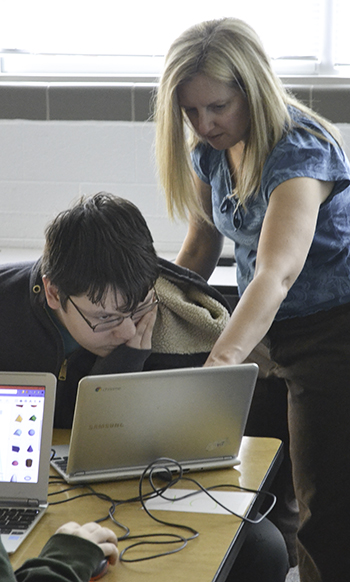
Tina Lehr works with a student during the TinkerCAD lesson.
Jefferson's STEM Specialist, Tina Lehr, was also excited about exposing her students to rapid prototyping. "This partnership allows students to work with new technologies and develop skills in the field of engineering." She was also excited about giving them "the opportunity to collaborate with local individuals who specialize in engineering."
Having the students make something useful was also key, according to Peterson: “A lot of 3D printing is focused on having fun with it and making toys,” he adds. “We wanted to try to do something that was more focused on how it would actually be used, not just as a novelty.” So, they decided the first item students would design was a 4 x 2 cm key chain; they didn’t want it to be too big, because it would take too long to print.
The lessons they designed were for a class that’s about half an hour long, and since that's not a lot of time per day, the lesson would extend over a period of several days. The lesson the first day was an overview of what 3D printing is, and about the TinkerCAD software, which has numerous different shapes which can be dropped, rearranged, reshaped. So the first day’s lesson emphasized the different tools the students would need to use to make their key chain, including how to put a holes into an object, how to make an object of a certain size and dimension, and, how to use the letters included in the software. (Several students put their initials on their keychains.) While the software is quite simple, Peterson acknowledges that “You can actually make a lot of complicated stuff with this if you really go for it.”
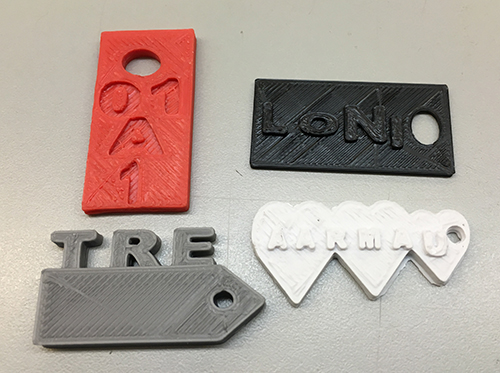
Some of the unique key chains students designed on TinkerCAD (photo courtesty of Tina Lehr).
On the second day, once they understood the basics of TinkerCAD, instead of just starting to design in the program itself, students then drew their designs with paper and pencil.
“Because when you’re actually designing something as an engineer, you usually start with sketches of what you’re going to do. You don’t start immediately in the simulation; you’re making a prototype.”
So they decided the next step would be for students to make a drawing of their design. “We thought that would be a good place to start so they could get a rough idea of what they wanted to make. I think it’s easier to make changes on paper than it is in the program. It’s easier to visualize the changes. And then they went into the program and tried to replicate this design.”
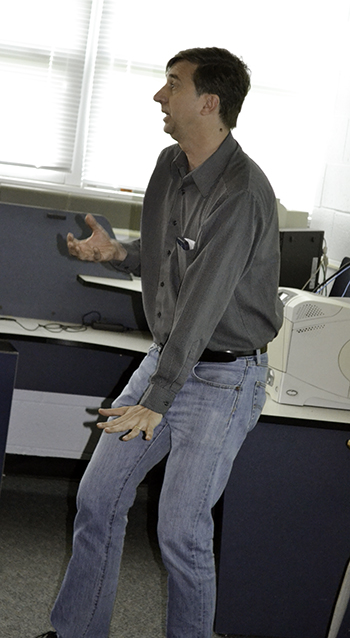
Joe Muskin explains how TinkerCAD works to a class of Jefferson Middle School students.
Another plus with using online software is that the students didn’t have to be in the classroom to work on their projects. A student with access to an online computer could log into the school’s central account, access their saved project, and work on it anywhere, including at home. “I think a lot of the students did that,” says Peterson, “because it gets them really excited about it.”
Based on what worked well and what didn’t the first time they did it in a classroom, Peterson and Muskin have changed the lesson plans accordingly.
“We had them design the thing first, and then go into CAD,” says Peterson. “But we found that because they hadn’t actually seen the software—there are some limitations to this, obviously; you can’t make very complicated shapes really easily—they were designing stuff that was a little too complicated. So we decided to change it up and give them some experience with this first, to see what its capabilities are, and then start designing it. And that actually helped a lot making the process faster, because they didn’t have to change their design.”
There’s another engineering aspect Peterson wants to include: having students go back and make improvements on their design once it's been printed:
“What I want to do in the future is maybe, after they make the first prototype, go back and redo anything they feel they want to change about it. Because once you get to actually hold it, that’s what a prototype is for. You get to see if there’s any changes you want to make. So I think that would be a good next step, if we could do another round. I think it’s maybe have students revisit their designs. I’d like to have them do it immediately after this; they go back. It’s part of the original design. It might be too expensive to print them twice, but I think it’s good to at least have the students revisit their designs and maybe not print them out again.”
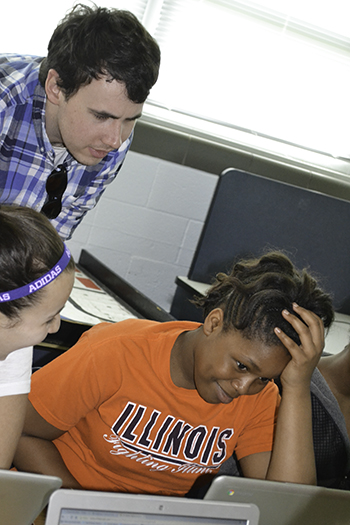
Kitt Peterson works with a middle school student who's having issues with her design.
Indicating that her students, "did a fantastic job!" Lehr also appreciated that her students had a chance to not only create a design, but problem solve and revisit their design to improve it:
"Each student worked hard to create his or her own original design. To do this they had to practice using the CAD program and their design had to meet certain specifications. It required them to problem solve, and complete the process of designing, testing, and redesigning."
Once Peterson and Muskin get all the kinks worked out of their curriculum, they’d like to see it become sustainable in the schools:
“We’re moving toward the teachers being able to teach this by themselves,” says Peterson. However, they’re not working themselves out of a job completely. They also envision scaling up the project down the road:
“We’ve talked about expanding it," admits Peterson. "We’re doing it this year with sixth graders; we were talking about, in the next year, maybe doing one for seventh graders, especially if there are students who did this in sixth grade, it would be nice to do something more in depth, maybe in 8th grade too.”
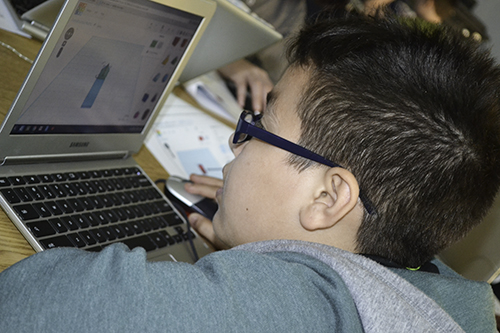
A middle school student working on his design in TinkerCAD.
Plus, because the students would be older and already have had previous experience in CAD design, he figures they would be able to try something a bit more difficult. “Because, I think with sixth grade, you have to really worry about getting the focus on it and get it done. You have to explain it more in detail. But if they’re older, you can go more in depth.”
Peterson’s career goal for the future is a faculty position; because while he wants to keep doing research, “I like teaching,” he admits.
It’s clear that he does, because he keeps coming up with new ideas for projects he wants to try out in the classroom:
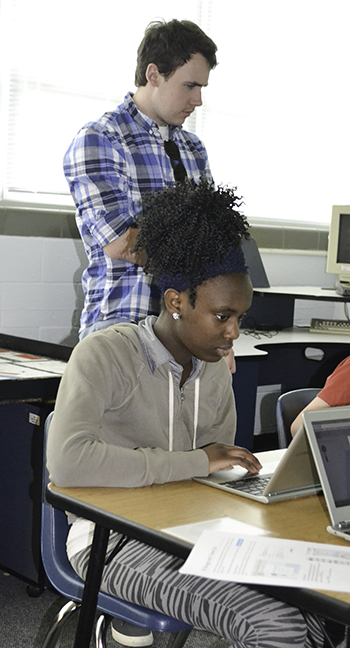
Kitt Peterson works with a student who's having issues with her design.
“I was thinking that it would be nice if there would be some way to do a project where you actually do some kind of simulation. Most of the engineering is done first in simulation, and then you make a prototype. But you always do a simulation first. So I was thinking something like that would be nice to bring into the classroom.”
He’s also got another project in the works that he thinks younger students would enjoy: “I’m working on another one. I worked on it a lot last semester and now I’m working with an undergrad student on it. "We call it a laser telephone. Instead of listening, you can talk into it, and there’s a circuit that picks it up across the room; you can actually hear the person talk into it in the other side of the room. So we’re hoping to go with that into another classroom too.”
So how did the students do? “It only took them a day or two to learn how to be pretty good with this,” Peterson admits. “It was good to see that they were excited about it in some ways. When you first start, they are not very into it. And then the next day they’re more excited about it.”
He also believes he saw a few future engineers in the group: “There were a couple students who were really into making good designs,” he says. “Obviously, there’s a lot of students who are more art focused, like making it fancy.”
Why would a grad student busy with his own studies and research take the time to develop a curriculum and take it into local classrooms? Peterson believes the hands-on aspect of the lesson and being exposed to the kinds of things engineers do has the potential to make science exciting for the students:
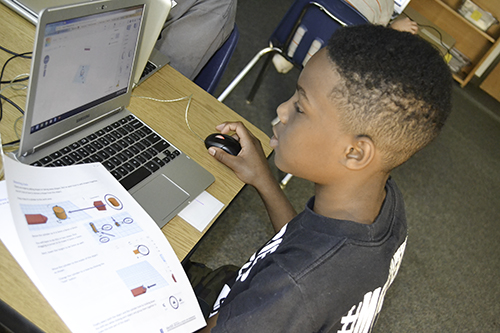
A Jefferson Middle School student learns the intricacies of TinkerCAD.
“I would hope that it helps them get excited about doing science type things. Because if you just teach science with equations and numbers and stuff, it’s hard for a lot of people to get excited about it. But when they actually can see it—because with the 3D printing you can actually see what you made in your hands and hold it. Because it goes from just a drawing to something to hold. That’s another thing with the lasers and the telephone. You can actually see it working. It works similarly to how a real telephone works, the same basic concepts. But if you can actually see it working...so I think that helps them gain interest in it."
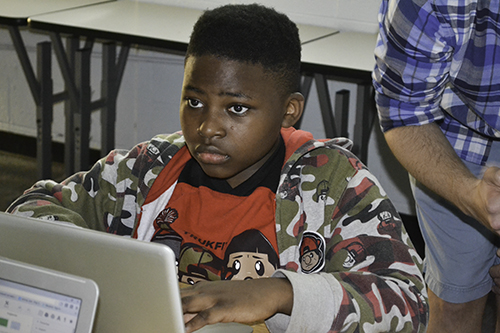
A Jefferson Middle School student using TinkerCAD to create his keychain.
Like Peterson, Lehr also hopes the project gets her students excited:
"I hope this project inspires students to explore the field of engineering, CAD and 3D prototyping even further, either either as a hobby or as a possible career choice. These are exciting new technologies that are making an impact in our lives today, and I am glad we had the opportunity to collaborate with Joe and Kitt to bring these opportunities to students at Jefferson."
Author/Photographer: Elizabeth Innes, Communications Specialist, I-STEM Education Initiative
More: 6-8 Outreach, ECE, Student Spotlight, 2016
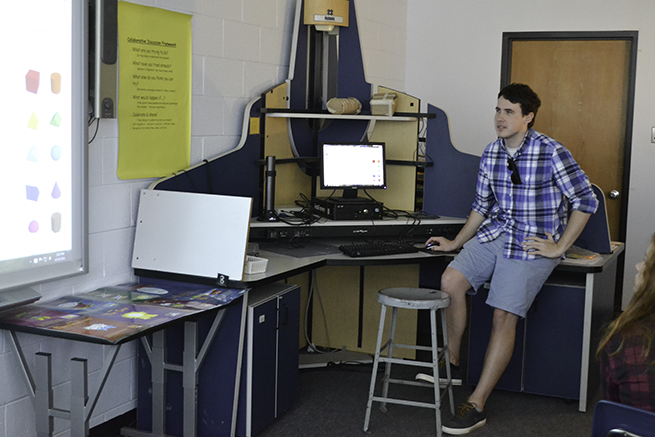
Kitt Peterson teaching Jefferson Middle School students about the various shapes available in TinkerCAD.













.jpg)
















